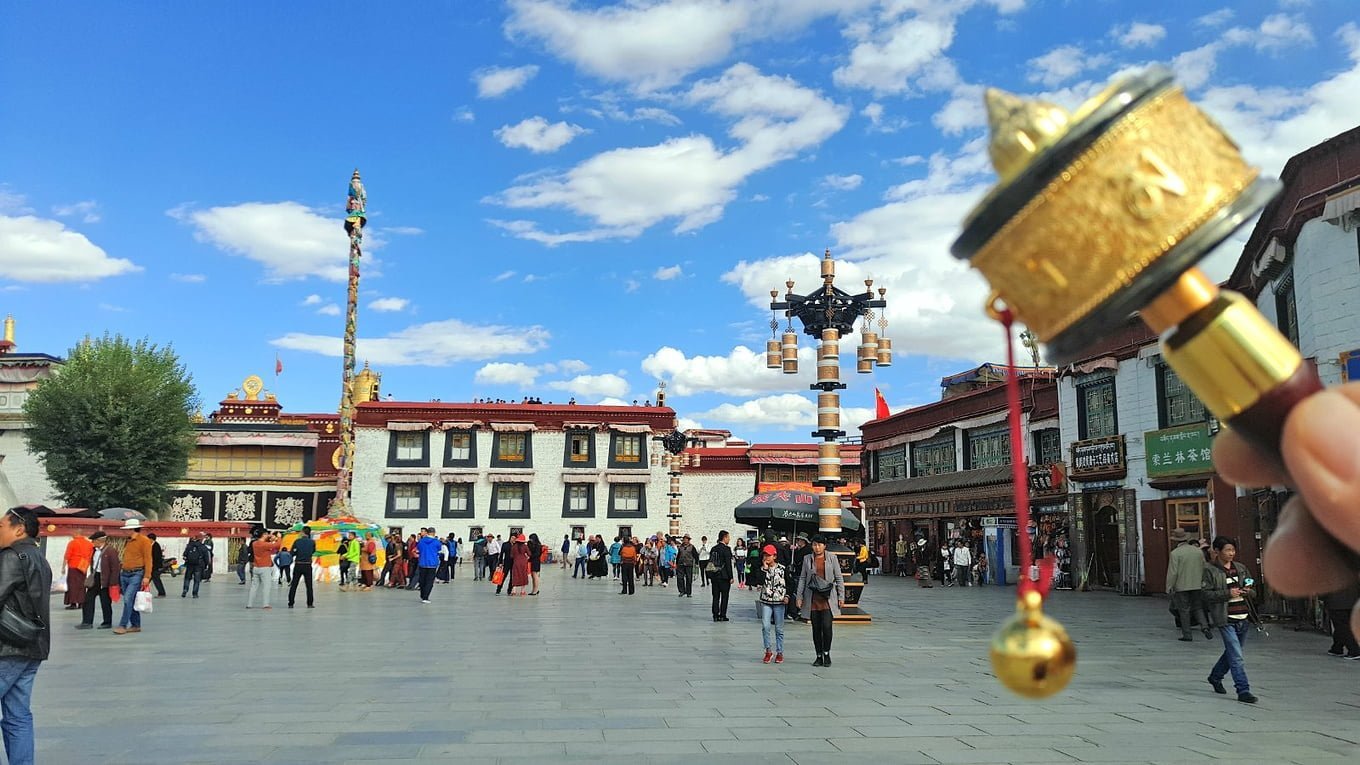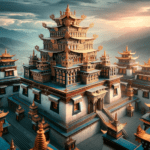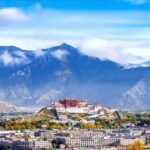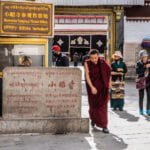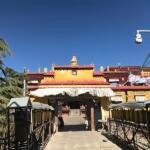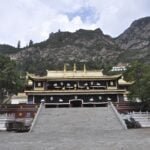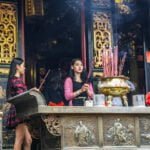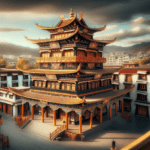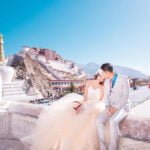Exploring the Jokhang Temple’s Rich History and Magnificent Architecture
In the heart of Lhasa’s historic district, you’ll find the revered Jokhang Temple, also known as “Tsuklakang.” Its history is intertwined with the birth of Lhasa itself, a city born from the temple’s initial name, “Rasa.” Over the centuries, under the rule of the Yuan, Ming, and Qing dynasties, the Jokhang Temple transformed into the grand edifice we see today.
A Sanctuary of Tibetan Buddhism
Established in 647 AD, the Jokhang Temple stands as a testament to Tibetan Buddhism’s significance. It houses a diverse collection of sculptures from different periods. Its most cherished resident is a life-sized statue of Sakyamuni, believed to be consecrated by the Buddha himself.
A Tale of Two Temples
Songtsen Gampo, an early Tibetan ruler, constructed the Ramoche Temple to enshrine the statue of Princess Wencheng. He also founded the Jokhang Temple, where he housed another life-sized statue of Sakyamuni, brought by Nepalese Princess Trizun. Unfortunately, both statues were lost during Tibet’s civil war, but the Jokhang Monastery endured and grew.
The Architectural Marvel of the Jokhang Temple
Upon reaching the gilded summit of the Jokhang Temple, you’re met with breathtaking vistas of the Jokhang Temple Square. To the right, you’ll spot the iconic Potala Palace, while Princess Willow stands beside it. The Jokhang Temple’s unique layout differs from traditional Buddhist temples, facing east and west with four towering stories and auxiliary halls. Its design follows the Buddhist mandala model, housing essential halls like the Sakyamuni Hall and Tsongkhapa Master Hall, among others, adorned with intricate wood carvings and murals.
Cultural Celebrations and Scholarly Pursuits
Step out from the temple’s main entrance, and you’ll enter a serene courtyard surrounded by 380 prayer wheels. In history, this space hosted the grand Lhasa Monlam Chenmo, attracting thousands of monks for prayer, debates, and various ceremonies. It was an important event started in 1409 AD, celebrating Sakyamuni’s victories over heretics. The courtyard is also where scholars earn the revered “Geshe” degree, equivalent to a doctorate in Tibetan Buddhist philosophy and metaphysics.
History in Murals and Stones
As you wander through the Jokhang Temple’s precinct, you’ll encounter the remarkable Thousand Buddha Gallery. This collonaded corridor features thousands of Buddha statues, and the entire temple boasts over 4,400 square meters of mesmerizing murals.
Exploring the Jokhang Temple’s Inner Sanctums
The main hall is home to the colossal statues of Padmasambhava, the Red Sect’s founder, and the future Buddha. As you delve deeper into the temple, you’ll discover remarkable historical murals and relics, each revealing the temple’s intricate history.
Barkhor Street: A Hub of Culture and Tradition
Winding around the Jokhang Temple, Bakhor Street, an ancient and lively commercial street, is a cultural gem. Known to locals as “Lhasa,” the area around the Jokhang Temple holds a special place in the hearts of Tibetans. It’s common to witness devotees prostrating themselves at the temple gate, making it a dynamic and spiritually charged environment.
A Legacy of Songtsen Gampo
During the 7th century, Emperor Songtsen Gampo played a pivotal role in establishing Tibet as a dominant regional power. He created laws, constructed temples, and married Princess Tritsun and Princess Wencheng. One of his crowning achievements was the Jokhang Temple, housing a statue of Sakyamuni brought by Princess Tritsun. The temple, an amalgamation of Tibetan, Tang Dynasty, Nepalese, and Indian architectural styles, reflects the history of its founding.
Preserving History in the Face of Challenges
The Jokhang Temple’s history spans over 1300 years, standing as an iconic symbol of Tibetan Buddhism. It’s the embodiment of Tubo-era architecture and holds a significant position in Tibetan Buddhism. Despite the challenges faced during the Cultural Revolution, it remains a beacon of faith and spirituality.
Setting the Record Straight
Historical accounts have raised questions about the Jokhang Temple’s statues being replaced or hidden. However, credible records suggest that the temple’s statues, particularly the 12-year-old Sakyamuni, remained unchanged.
The Jokhang Temple is a testament to Tibet’s profound spiritual heritage, a living history that continues to inspire awe and devotion in the hearts of all who visit.
Exploring the Mysteries of the Jokhang Temple Statues
Unveiling the Truth Behind the Iconic Jowo Sakyamuni Statue
Mysteries have shrouded the history of the Jokhang Temple’s revered statues, particularly the 12-year-old Jowo Sakyamuni. While some accounts suggest the replacement or concealment of these sacred relics, credible historical records offer a different narrative.
The Legend of Concealment
One story contends that the Tang military sought to seize the Jowo Sakyamuni statue, prompting Tibetans to conceal it within the Jokhang Temple. To protect it, they masked the statue with mud and painted Manjusri over it. However, this account lacks substantial evidence.
The Jowo Sakyamuni Statue and Its History
Reliable historical records reveal that the Jowo Sakyamuni statue, brought by Princess Wencheng from China, remained unchanged upon arrival at the Jokhang Temple. These records suggest that the Tang-Tibet battles, while significant, occurred far from Lhasa and did not warrant hiding or altering the statues.
The Historical Reality
Historical accuracy prevails over the embellished tales of statue replacement. The Jokhang Temple and its iconic statues have played a pivotal role in preserving Tibetan Buddhism’s rich heritage. The journey of the Jowo Sakyamuni statue, unaltered since its arrival, stands as a testament to the enduring faith of Tibetan Buddhism.
The Jokhang Temple continues to be a sanctuary of spirituality and cultural significance, preserving a legacy that transcends time and challenges.
Delving Deeper: The Enigmatic History of Jokhang Temple Statues
Unveiling the Truth Behind the Iconic Jowo Sakyamuni Statue
The Jokhang Temple, nestled in the heart of Lhasa, holds a mystique that extends far beyond its serene façade. At the core of its enigma lies the fascinating history of its most treasured possessions – the statues that have borne witness to centuries of devotion, faith, and cultural transformation.
The Jowo Sakyamuni Statue: A Treasured Icon
Central to the Jokhang Temple’s history is the Jowo Sakyamuni, a life-sized statue of Lord Buddha. Princess Wencheng, a Chinese royal, is credited with bringing this remarkable statue to Tibet during the Tang Dynasty. This statue, revered for its alleged consecration by Sakyamuni himself, holds a place of utmost significance in Tibetan Buddhism.
The Fabled Concealment Story
One of the tales that have perpetuated over time suggests that the Jowo Sakyamuni statue was hidden from the Tang military. It is said that Tibetans, to protect their precious relic, concealed it within the Jokhang Temple, covering it with mud and painting an image of Manjusri over it. The rationale behind this act was to shield the statue from being seized during a tumultuous period.
Scrutinizing the Legend
While this account has been told and retold, historical veracity points towards a different narrative. Contrary to the tales of statue concealment, substantial historical evidence asserts that the Jowo Sakyamuni statue did not undergo any changes upon its arrival in Tibet. Battles between the Tang Dynasty and Tibet were undoubtedly significant, but they occurred in areas far from Lhasa, making the need for concealing the statue questionable.
Preservation of a Precious Legacy
What stands undeniably true is that the Jokhang Temple and its esteemed statues have played a pivotal role in preserving Tibetan Buddhism’s rich heritage. The Jowo Sakyamuni statue remains unaltered and unblemished, an enduring symbol of unwavering faith and spiritual devotion.
The Jokhang Temple, with its statues and sacred artefacts, embodies a cultural legacy that has withstood the test of time and adversities. It continues to be a place of worship, cultural significance, and historical intrigue, offering us a glimpse into the mysteries of Tibet’s spiritual past.

